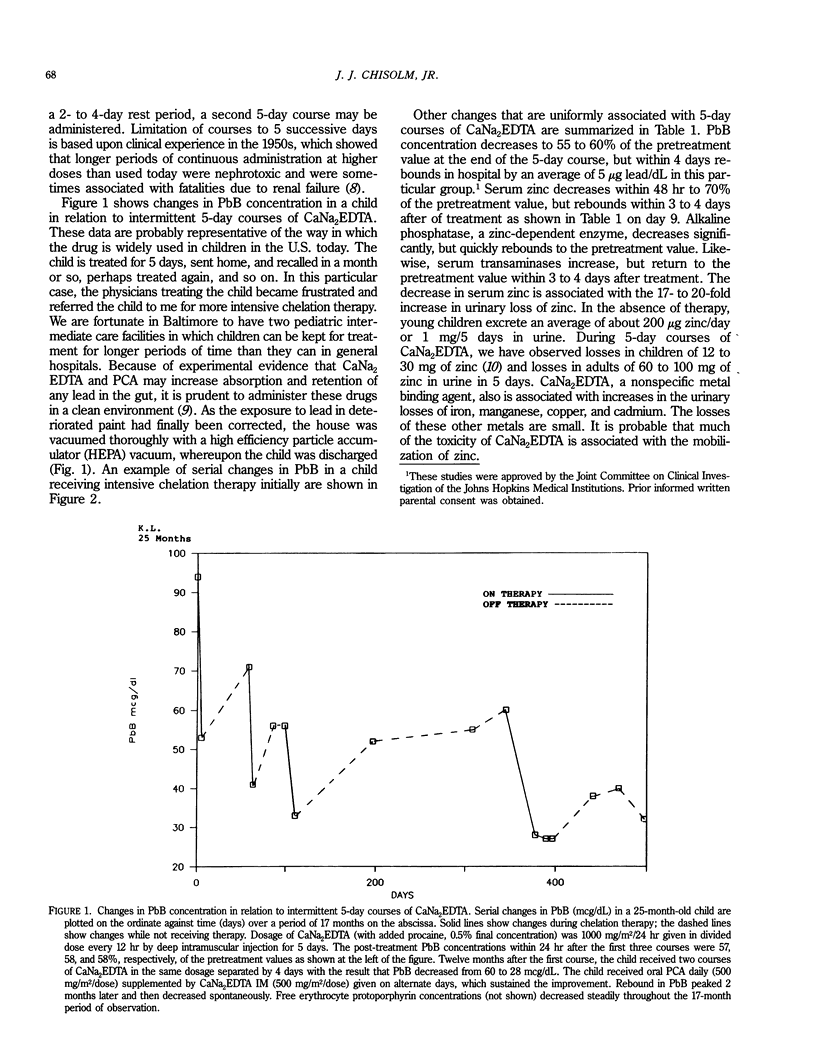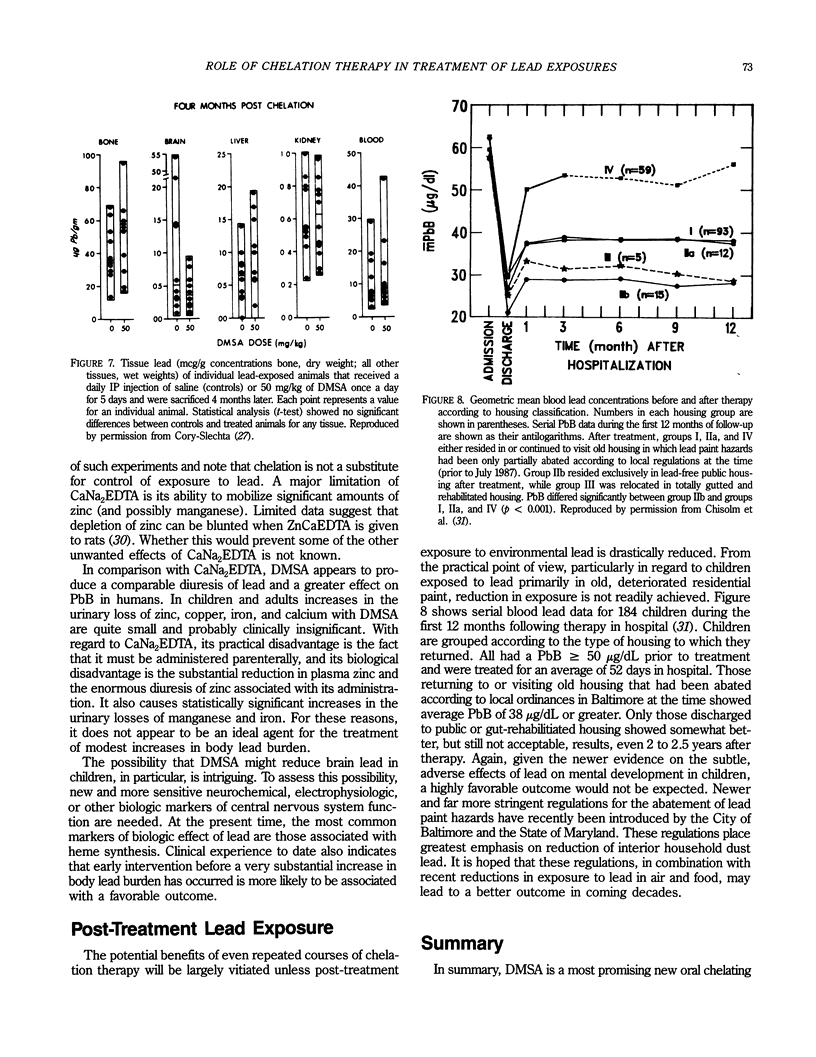Abstract
In the overall long-term management of lead poisoning, chelation therapy can have short-term benefits; however, these benefits must be accompanied by drastic reduction in environmental exposure to lead if therapy is to have any long-term benefit. This discussion is limited to calcium disodium ethylenediaminetetraacetate (CaNa2EDTA), the chelating agent that has been the mainstay of treatment of lead poisoning for the past 38 years, and to meso-2,3-dimercaptosuccinic acid (DMSA), a new and promising oral chelating agent, which is an orphan drug and is currently classified as an investigational new drug by the U.S. Food and Drug Administration. With both drugs, multiple courses of treatment will be needed if any substantial reduction in body lead burden is to be achieved. A major limitation of CaNa2EDTA is the enormous diuresis of zinc that it produces. DMSA produces a comparable diuresis of lead, a greater decrease in blood lead, and has negligible influence on the urinary losses of zinc, copper, iron, and calcium. Limited experience to date in man has revealed no significant adverse side effects of DMSA. In animals, DMSA will promptly reduce the concentration of lead in brain and kidney, in particular. By contrast, similar 5-day courses of CaNa2EDTA do not produce any net reduction in brain lead. This is important, as the brain is the critical organ of the adverse effects of lead in children. If the efficacy of DMSA is to be comprehensively evaluated ethically in children, new and more sensitive neurochemical, electrophysiologic, or other markers must be developed.
Full text
PDF







Selected References
These references are in PubMed. This may not be the complete list of references from this article.
- Aaseth J. Recent advance in the therapy of metal poisonings with chelating agents. Hum Toxicol. 1983 Apr;2(2):257–272. doi: 10.1177/096032718300200214. [DOI] [PubMed] [Google Scholar]
- Aposhian H. V. DMSA and DMPS--water soluble antidotes for heavy metal poisoning. Annu Rev Pharmacol Toxicol. 1983;23:193–215. doi: 10.1146/annurev.pa.23.040183.001205. [DOI] [PubMed] [Google Scholar]
- Araki S., Aono H., Fukahori M., Tabuki K. Behavior of lead and zinc in plasma, erythrocytes, and urine and ALAD in erythrocytes following intravenous infusion of CaEDTA in lead workers. Arch Environ Health. 1984 Sep-Oct;39(5):363–367. doi: 10.1080/00039896.1984.10545865. [DOI] [PubMed] [Google Scholar]
- Araki S., Aono H., Murata K. Mobilisation of heavy metals into the urine by CaEDTA: relation to erythrocyte and plasma concentrations and exposure indicators. Br J Ind Med. 1986 Sep;43(9):636–641. doi: 10.1136/oem.43.9.636. [DOI] [PMC free article] [PubMed] [Google Scholar]
- Bankowska J., Hine C. Retention of lead in the rat. Arch Environ Contam Toxicol. 1985 Sep;14(5):621–629. doi: 10.1007/BF01055393. [DOI] [PubMed] [Google Scholar]
- Brownie C. F., Aronson A. L. Comparative effects of Ca-ethylenediaminetetraacetic acid (EDTA), ZnEDTA, and ZnCaEDTA in mobilizing lead. Toxicol Appl Pharmacol. 1984 Sep 15;75(2):167–172. doi: 10.1016/0041-008x(84)90198-4. [DOI] [PubMed] [Google Scholar]
- Chisolm J. J., Jr Management of increased lead absorption and lead poisoning in children. N Engl J Med. 1973 Nov 8;289(19):1016–1018. doi: 10.1056/NEJM197311082891906. [DOI] [PubMed] [Google Scholar]
- Chisolm J. J., Jr, Mellits E. D., Quaskey S. A. The relationship between the level of lead absorption in children and the age, type, and condition of housing. Environ Res. 1985 Oct;38(1):31–45. doi: 10.1016/0013-9351(85)90070-2. [DOI] [PubMed] [Google Scholar]
- Chisolm J. J., Jr Mobilization of lead by calcium disodium edetate. A reappraisal. Am J Dis Child. 1987 Dec;141(12):1256–1257. doi: 10.1001/archpedi.1987.04460120018020. [DOI] [PubMed] [Google Scholar]
- Chisolm J. J., Jr The use of chelating agents in the treatment of acute and chronic lead intoxication in childhood. J Pediatr. 1968 Jul;73(1):1–38. doi: 10.1016/s0022-3476(68)80036-8. [DOI] [PubMed] [Google Scholar]
- Chisolm J. J., Jr, Thomas D. J. Use of 2,3-dimercaptopropane-1-sulfonate in treatment of lead poisoning in children. J Pharmacol Exp Ther. 1985 Dec;235(3):665–669. [PubMed] [Google Scholar]
- Cory-Slechta D. A. Mobilization of lead over the course of DMSA chelation therapy and long-term efficacy. J Pharmacol Exp Ther. 1988 Jul;246(1):84–91. [PubMed] [Google Scholar]
- Cory-Slechta D. A., Weiss B., Cox C. Mobilization and redistribution of lead over the course of calcium disodium ethylenediamine tetraacetate chelation therapy. J Pharmacol Exp Ther. 1987 Dec;243(3):804–813. [PubMed] [Google Scholar]
- Dhawan M., Kachru D. N., Tandon S. K. Influence of thiamine and ascorbic acid supplementation on the antidotal efficacy of thiol chelators in experimental lead intoxication. Arch Toxicol. 1988;62(4):301–304. doi: 10.1007/BF00332491. [DOI] [PubMed] [Google Scholar]
- FOREMAN H., FINNEGAN C., LUSHBAUGH C. C. Nephrotoxic hazard from uncontrolled edathamil calcium-disodium therapy. J Am Med Assoc. 1956 Mar 24;160(12):1042–1046. doi: 10.1001/jama.1956.02960470038010. [DOI] [PubMed] [Google Scholar]
- FOREMAN H. Use of chelating agents in treatment of metal poisoning (with special emphasis on lead). Fed Proc. 1961 Sep;20(3):191–196. [PubMed] [Google Scholar]
- FRIEDHEIM E. A., DA SILVA J. R., MARTINS A. V. Treatment of schistosomiasis mansoni with antimony-omega, omega-dimercapto-potassium succinate (TWSb). Am J Trop Med Hyg. 1954 Jul;3(4):714–727. doi: 10.4269/ajtmh.1954.3.714. [DOI] [PubMed] [Google Scholar]
- Flood P. R., Schmidt P. F., Wesenberg G. R., Gadeholt H. The distribution of lead in human hemopoietic tissue and spongy bone after lead poisoning and Ca-EDTA chelation therapy. Observations made by atomic absorption spectroscopy, laser microbeam mass analysis and electron microbeam X-ray analysis. Arch Toxicol. 1988;62(4):295–300. doi: 10.1007/BF00332490. [DOI] [PubMed] [Google Scholar]
- Goldstein G. W., Asbury A. K., Diamond I. Pathogenesis of lead encephalopathy. Uptake of lead and reaction of brain capillaries. Arch Neurol. 1974 Dec;31(6):382–389. doi: 10.1001/archneur.1974.00490420048005. [DOI] [PubMed] [Google Scholar]
- Goyer R. A., Cherian M. G. Ascorbic acid and EDTA treatment of lead toxicity in rats. Life Sci. 1979 Jan 29;24(5):433–438. doi: 10.1016/0024-3205(79)90215-7. [DOI] [PubMed] [Google Scholar]
- Graziano J. H., Leong J. K., Friedheim E. 2,3-Dimercaptosuccinic acid: a new agent for the treatment of lead poisoning. J Pharmacol Exp Ther. 1978 Sep;206(3):696–700. [PubMed] [Google Scholar]
- Graziano J. H., Lolacono N. J., Meyer P. Dose-response study of oral 2,3-dimercaptosuccinic acid in children with elevated blood lead concentrations. J Pediatr. 1988 Oct;113(4):751–757. doi: 10.1016/s0022-3476(88)80396-2. [DOI] [PubMed] [Google Scholar]
- Graziano J. H., Siris E. S., LoIacono N., Silverberg S. J., Turgeon L. 2,3-Dimercaptosuccinic acid as an antidote for lead intoxication. Clin Pharmacol Ther. 1985 Apr;37(4):431–438. doi: 10.1038/clpt.1985.67. [DOI] [PubMed] [Google Scholar]
- Jugo S., Maljković T., Kostial K. Influence of chelating agents on the gastrointestinal absorption of lead. Toxicol Appl Pharmacol. 1975 Nov;34(2):259–263. doi: 10.1016/0041-008x(75)90030-7. [DOI] [PubMed] [Google Scholar]
- Kapoor S. C., Wielopolski L., Graziano J. H., LoIacono N. J. Influence of 2,3-dimercaptosuccinic acid on gastrointestinal lead absorption and whole-body lead retention. Toxicol Appl Pharmacol. 1989 Mar 1;97(3):525–529. doi: 10.1016/0041-008x(89)90257-3. [DOI] [PubMed] [Google Scholar]
- McMichael A. J., Baghurst P. A., Wigg N. R., Vimpani G. V., Robertson E. F., Roberts R. J. Port Pirie Cohort Study: environmental exposure to lead and children's abilities at the age of four years. N Engl J Med. 1988 Aug 25;319(8):468–475. doi: 10.1056/NEJM198808253190803. [DOI] [PubMed] [Google Scholar]
- Oskarsson A., Ljungberg T., Ståhle L., Tossman U., Ungerstedt U. Behavioral and neurochemical effects after combined perinatal treatment of rats with lead and disulfiram. Neurobehav Toxicol Teratol. 1986 Sep-Oct;8(5):591–599. [PubMed] [Google Scholar]
- Rabinowitz M. B., Wetherill G. W., Kopple J. D. Kinetic analysis of lead metabolism in healthy humans. J Clin Invest. 1976 Aug;58(2):260–270. doi: 10.1172/JCI108467. [DOI] [PMC free article] [PubMed] [Google Scholar]
- Thomas D. J., Chisolm J., Jr Lead, zinc and copper decorporation during calcium disodium ethylenediamine tetraacetate treatment of lead-poisoned children. J Pharmacol Exp Ther. 1986 Dec;239(3):829–835. [PubMed] [Google Scholar]
- Wang S. C., Ting K. S., Wu C. C. Chelating therapy with Na-DMS in occupational lead and mercury intoxications. Chin Med J. 1965 Jul;84(7):437–439. [PubMed] [Google Scholar]


